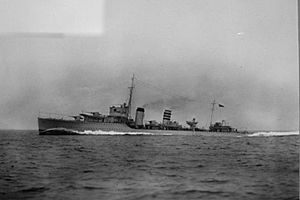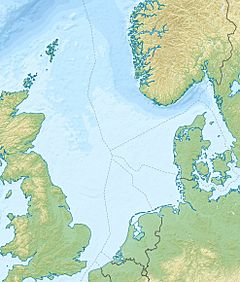SS Abukir facts for kids
Quick facts for kids History |
|
|---|---|
| Name |
|
| Namesake | Abu Qir, Egypt |
| Owner |
|
| Operator |
|
| Port of registry | |
| Builder | Swan, Hunter & Wigham Richardson, Wallsend |
| Yard number | 1159 |
| Launched | 27 September 1920 |
| Completed | November 1920 |
| Identification | |
| Fate | Sunk by torpedo from German E-boat S-34, 28 May 1940 |
| General characteristics | |
| Type | coaster |
| Tonnage | 689 GRT, 355 NRT |
| Length | 173.5 ft (52.9 m) |
| Beam | 28.1 ft (8.6 m) |
| Draught | 13 ft 5 in (4.09 m) |
| Depth | 12.9 ft (3.9 m) |
| Installed power | 97 IHP |
| Propulsion | 3-cylinder triple-expansion steam engine; single screw |
| Speed | 8 knots (15 km/h) |
| Armament | (as DEMS) 1 Lewis gun |
| Armour | concrete slabs to protect the bridge from machine-gun fire |
The SS Abukir was a British coastal steamship. She was first launched in 1920 as the SS Island Queen and later renamed SS Kyle Queen in 1934. In 1935, she became Abukir and was registered in Egypt.
In May 1940, during World War II, the Abukir was helping to evacuate soldiers and civilians from Ostend, Belgium. She was hit by a torpedo from a German E-boat in the North Sea and sadly sank. This happened on the very last day of the Battle of Belgium.
Contents
Building and Early Life of the Ship
The Abukir was built by Swan, Hunter and Wigham Richardson in Wallsend, England. She was finished in November 1920. The ship had a steam engine that used three cylinders to turn a single screw, allowing her to move through the water.
She was first named Island Queen and belonged to the London and Channel Islands Steamship Company. In 1934, she was sold to Monroe Brothers of Liverpool and renamed Kyle Queen. Just a year later, in 1935, she was sold again to the Khedivial Mail Steamship and Graving Dock Company in Alexandria, Egypt. This company, also known as the Khedivial Mail Line (KML), renamed her Abukir. The name came from a coastal town called Abu Qir in Egypt.
On March 22, 1939, the Abukir got stuck in the ground near Larnaca, Cyprus. Luckily, she was pulled free six days later.
Joining the War Effort
Even though Egypt was supposed to be independent, the British Empire had a lot of control there. In 1940, during World War II, the UK Ministry of War Transport took over seven KML ships, including the Abukir. They put five of these ships under the care of the General Steam Navigation Company.
On May 10, 1940, Germany invaded the Low Countries (like Belgium and the Netherlands). British and French armies moved into Flanders, Belgium, to help. The Abukir was sent to the Port of Ostend in Belgium, where she delivered supplies for the British army.
However, German forces broke through the French lines and reached the English Channel on May 20. This trapped the British and French armies in northern Flanders. They had to retreat towards Ostend, Nieuwpoort, and Dunkirk. On May 27, a large evacuation called Operation Dynamo began at Dunkirk.
That same afternoon, a British military group reported that King Leopold III of Belgium planned to surrender to Germany. This group quickly went to the Port of Ostend, where the Abukir was waiting. More than 200 British soldiers and airmen, along with Belgian airmen, crowded onto the ship. There were also 15 German prisoners of war, six priests, and about 40 to 50 women, including nuns and British schoolgirls. At 10:20 PM, under the cover of darkness, the small ship set sail for England.
Attacks from Air and Sea
As the Abukir slowly sailed towards England, German Luftwaffe aircraft bombed her for an hour and a half. But they didn't hit the ship. Then, at 1:15 AM on May 28, a fast German Kriegsmarine E-boat called S-34 attacked her near Nieuwpoort.
The Abukir's Captain, Rowland Morris-Woolfenden, steered the ship in a zigzag pattern. This helped the ship avoid two torpedoes from S-34. Twenty minutes later, the Abukir saw S-34 again. Captain Morris-Woolfenden tried to ram the torpedo boat, but the Abukir was too slow, with a top speed of only 8 knots (15 km/h).
S-34 fired two more torpedoes. The first one missed, but the second one hit the Abukir in the middle, splitting her in two. The ship immediately caught fire and sank within a minute. It was the first Allied ship ever sunk by an E-boat.
Many people on board died when the ship was hit and sank. Tragically, the S-34 then used a searchlight to find survivors in the water and fired machine guns at them. The Abukir's Second Officer, Patrick Wills-Rust, was on the bridge when the ship was hit. Concrete slabs, put there to protect the bridge, trapped him. He went down with the ship, but as the ship settled on the seabed, the slabs moved, freeing him. He was able to swim back to the surface.
At dawn, five Royal Navy destroyers came to look for survivors. These ships were HMS Anthony, Codrington, Grenade, Jaguar, and Javelin. They searched for several hours and found only a small number of people alive, between 26 and 33. Among them were Captain Morris-Woolfenden, Sub-lieutenant Wills-Rust, and two nuns. About 480 people who were on the Abukir were killed. Most of the survivors were rescued by HMS Codrington. They had been in the cold water for six hours.
Awards for Bravery
In December 1940, Lloyd's of London created a new award called the Lloyd's War Medal for Bravery at Sea. This award recognized the many brave acts of sailors during the war. Captain Morris-Woolfenden received the very first medal, and Sub-lieutenant Wills-Rust received the second. Captain Morris-Woolfenden also received the MBE.
Both officers survived the war and continued their careers at sea. In 1956, Morris-Woolfenden was still a captain with the KML. Wills-Rust was promoted in the RNR and later became a Master in the Merchant Navy before he retired.
Memorials and the Wreck Site
Those who died on the Abukir are remembered on various memorials. Fourteen of the Abukir's crew, including the First Officer, L.J. Evans, are named on the Merchant Navy Monument at Tower Hill in London. A 17-year-old Merchant Navy seaman named William Blair is also listed on a memorial plaque in Holy Trinity parish church at Ingham, Norfolk.
British soldiers who died on the Abukir are named on panels of the Dunkirk Memorial in Dunkirk Town Cemetery. Airmen from the British and Belgian air forces who were killed are named on panels of the Air Forces Memorial at Englefield Green in Surrey.
In 1969, a diver found the Abukir's wreck off the coast of Nord-Pas-de-Calais in northern France. Items found at the wreck site included plates, cups, teapots, and cutlery with the initials "KML" (for Khedivial Mail Line). They also found rifle ammunition and rosary beads.
Sources



